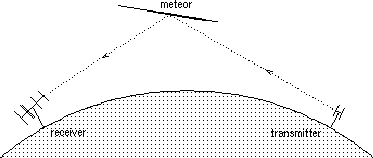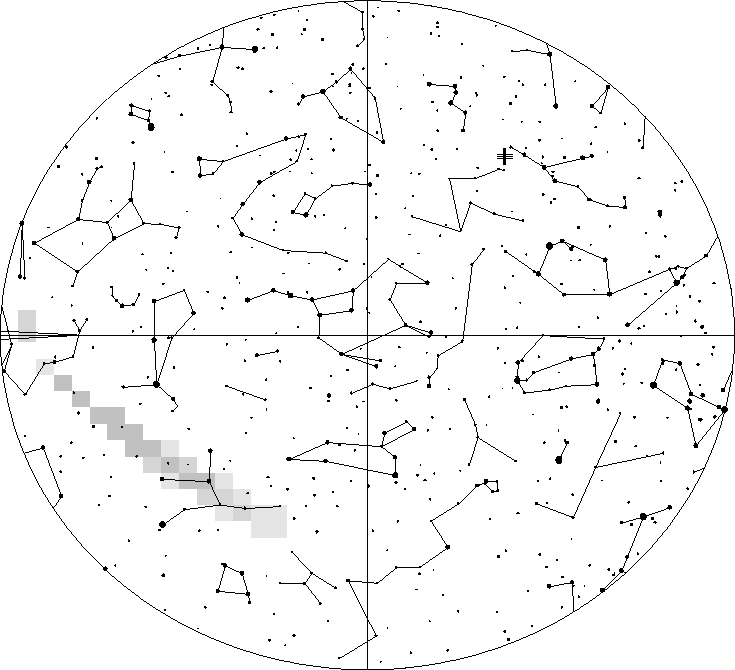The general principle of meteor observation by forward scattering of radio waves off their trails is easy to understand. It is illustrated in Figure 1. A lower VHF radio receiver (30-100 MHz) is located at a large distance (about 500-2000 km) from a transmitter at the same frequency. Direct radio contact is impossible due to the curvature of the Earth. When a meteor enters the atmosphere, its trail may reflect the radio waves from the transmitter to the receiver. At the receiver, where the signal of the transmitter is normally not received, the transmission can then be received for a moment, as long as the meteor trail is present. Such reflections can last from a tenth of a second to a few minutes. The received signal characteristics are related to physical parameters of the meteoric event.
 Figure 1 – The principle of forward scatter
Figure 1 – The principle of forward scatterobservation of meteors. Signals from a radio transmitter are scattered to a receiver by a meteor trail, thus enabling the detection of the meteor.
Forward scattering of radio waves off meteor trails is used in astronomy to determine meteor parameters, and in the communications world to send small amounts of data over large distances at VHF frequencies. Both interest groups are composed of amateurs and professionals.
In order to extract physical data (like velocity, mass, stream membership, …) about meteors from radio observations, a good theory is necessary. The classical theory for radio meteor observations was developed mainly in the 1940’s and 1950’s (see [13] for an overview of the history). The main emphasis then was on backscatter (radar) observations. Forward scattering received much less attention, since the theory and the interpretation of the observations are severely complicated by a more complex geometry. However, the classical theory has been extrapolated to include forward scatter geometries. It can be used for a rough approach of meteor scattering problems.
Later on, more general numerical approaches to the scattering problem have been used, like the full wave theory [8], ray tracing techniques [12], and the long wavelength approximation [9]. These theories should be used when thoroughly reducing the observations.
 Figure 2 – Reflection of radio waves on meteor trails is specular
Figure 2 – Reflection of radio waves on meteor trails is specularOne of the most important characteristics of the reflection of radio waves off meteor trails is that the reflection is specular. You can therefore think of the transmitter as a light bulb and of a meteor as a long mirror. The observer sees the light bulb in one point of the mirror. This is important, as all the data derived from the features of the observed meteor profile apply only to this part of the trail. The location of the specular point only depends on the geometry of the reflection, i.e. the location of the transmitter, the receiver and the meteor trajectory.The radio signals from the transmitter thus effectively only reflect on a limited portion of the trail, and only suitably oriented meteor trails can yield a detectable signal at the receiver site. While this has no directly noticeable influence on the observation of sporadic meteors, it has significant consequences for the observation of stream meteors. As explained in [26], specularity has as a consequence that meteors from a given stream only yield reflections in a very limited strip of the sky (see Figure 2), determined by the position of the radiant in the sky, as well as by the location of the transmitter and the receiver site.
 Figure 3 – Meteor reflections from a given stream will appear only in a strip in the sky as seen from the receiver site. This figure is an example calculated by Project Meteor, a program by Paul Vauterin. It shows where the Perseids are to appear for the meteor set-up in Ghent, Belgium, at 13h UT on August 12.
Figure 3 – Meteor reflections from a given stream will appear only in a strip in the sky as seen from the receiver site. This figure is an example calculated by Project Meteor, a program by Paul Vauterin. It shows where the Perseids are to appear for the meteor set-up in Ghent, Belgium, at 13h UT on August 12.In the amateur radio meteor world, it is customary to use existing transmitters for forward scatter experiments. Popular transmitters are public FM broadcast stations, TV stations and amateur beacons, but sometimes other stations are used too, like for instance professional ionosphere radars. The use of existing transmitters of course has the advantage that one does not have to care about the setting up, the maintenance or the costs of the transmitter. However, there are a number of serious limitations resulting from the use of such transmitters.
Probably the most important problem is that, within a radius of 2000 km from a given receiver site, a multitude of these kinds of radio stations broadcast at a given frequency. Therefore, the reflection geometry of a given reflection on a meteor trail is totally unknown, as it is generally not known which transmitter powered a particular reflection. Another problem is the lack of control and knowledge of transmitter parameters. One does not know when a station is switched on or off, the modulation of the carrier wave may alter the received power, the radiation pattern of the transmitter antenna is generally not known, …

